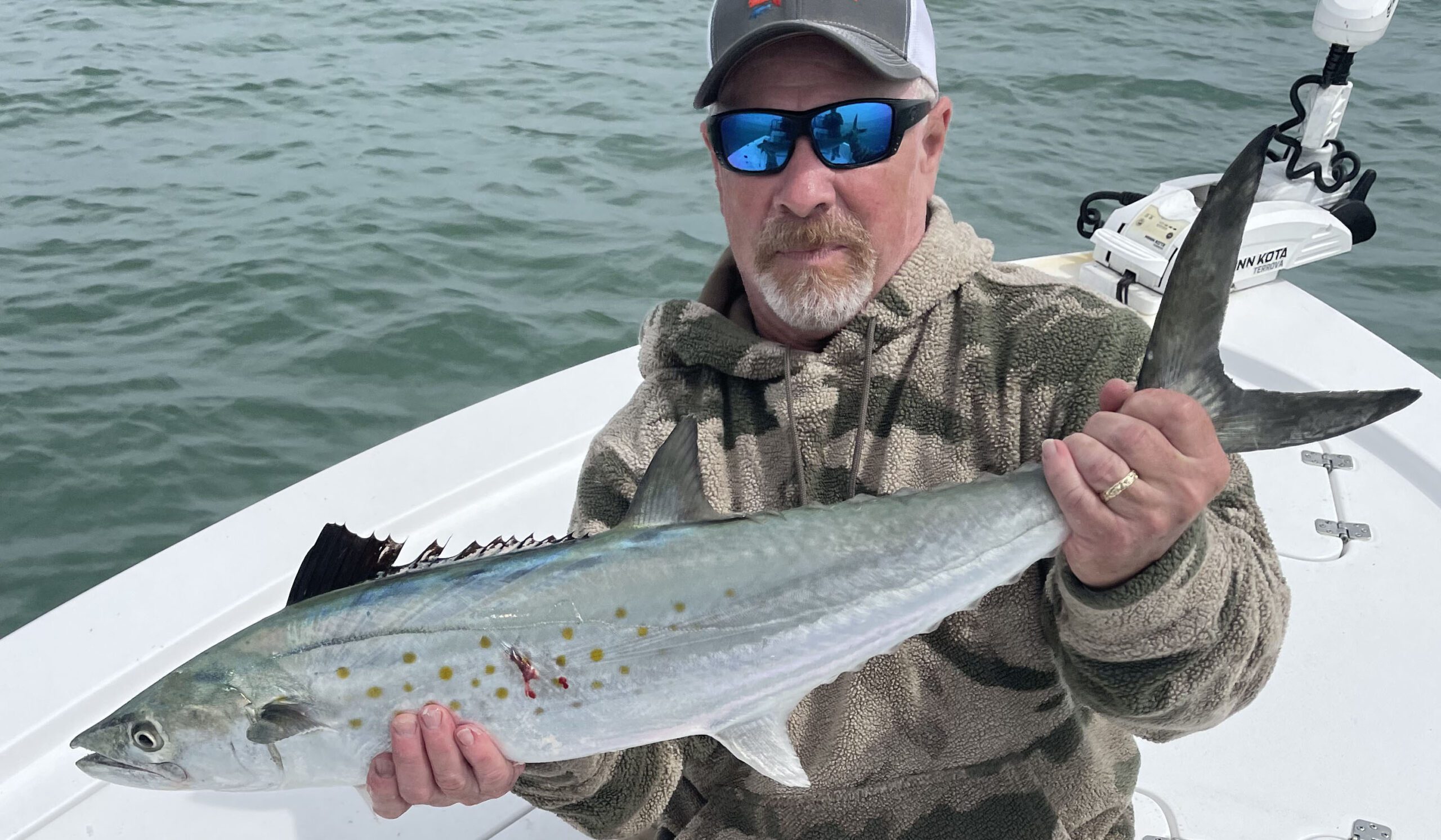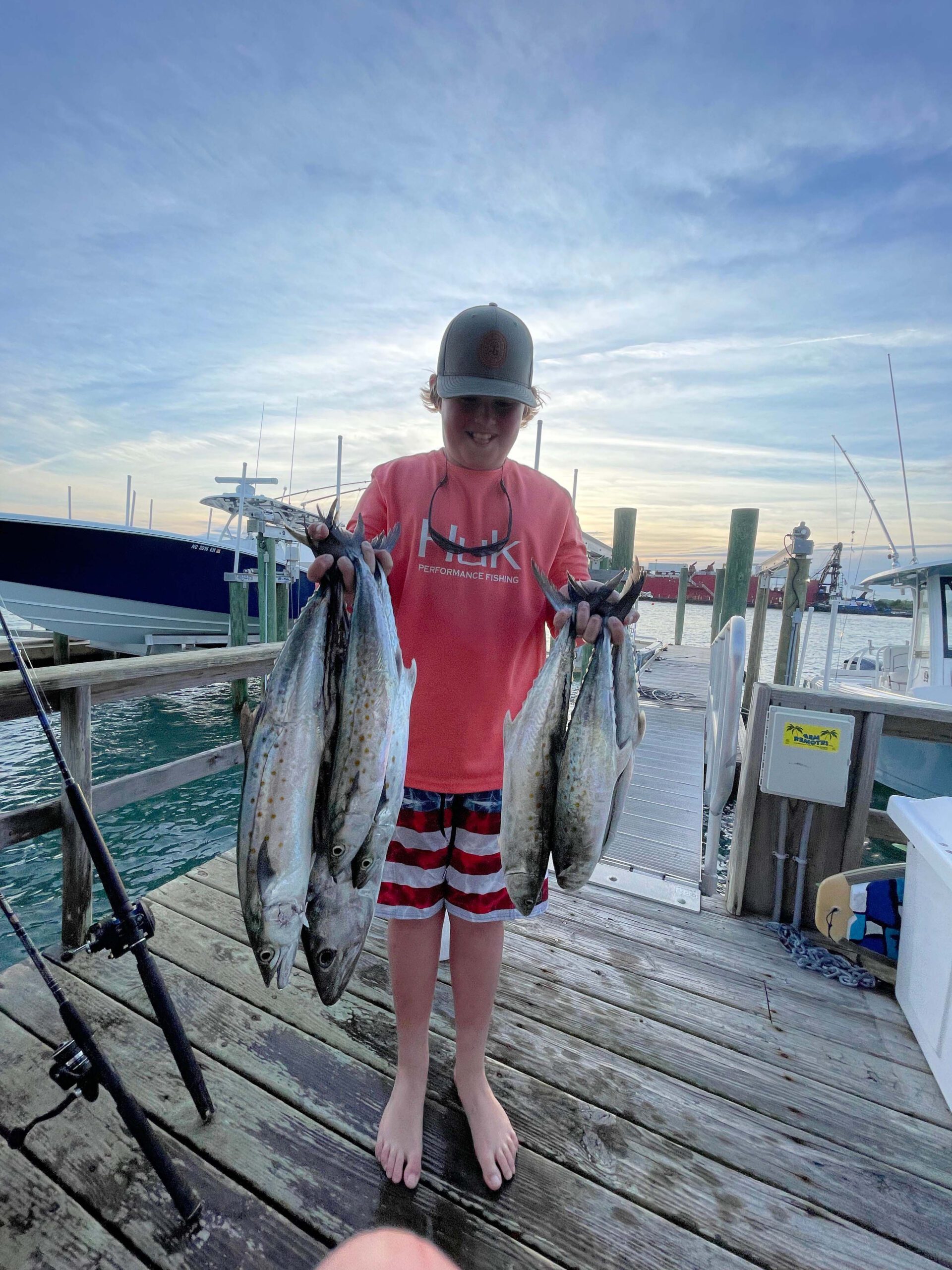Carolina Beach – May 2022
Andrew, of Island Tackle and Hardware, reports that surf anglers have been catching some good-sized pompano recently, with a few citations mixed in.
Bottom fishing deeper holes along the surf zone has been producing whiting, black drum, and few bluefish, and cut baits are getting strikes from some of the red drum working along the beach.
Inshore anglers are starting to catch sheepshead as they move in from their nearshore winter spots.
Both black and red drum are feeding around docks or oyster shell structures along the ICW and back into the Cape Fear River.
Nearshore fishing has started to pick up, with spanish mackerel now being caught by anglers trolling the beaches or ARs with Clarkspoons. A few Atlantic bonito are mixed in for anglers starting their fishing action in the early mornings.

Eddie Moser, of Burlington, hooked this 7.1 lb. citation spanish mackerel on a Gotcha plug offshore of Masonboro Island. He was fishing with Capt. Luke Moser of Coastline Charters.
Christian, of Seahawk Inshore Fishing Charters, reports that anglers have been finding good action on black drum from 14-18”, with some better-sized (20”) fish mixed in.
The red drum bite has also been picking up, as the warmer water temperatures have these fish on the move. Most have been smaller reds, but there are some slot-sized fish as well. Shell beds and other inshore hard structures have been holding both of the drum species. Fishing during times of moving tide has been best, but the key is to find areas with not too much current where you can’t keep bait down.
Mason, of Grand Slam Fishing Charters, reports that black drum fishing is starting to kick into full swing for anglers fishing Carolina-rigged fiddler crabs, mud crabs, or dead shrimp. Areas of inshore hard structure such as docks, oyster bars, and rocks are the best places to start fishing efforts. Moving water has been important, with the bite tending to slow down around slack tides.
Red drum are in a big transition time right now as schools break up into smaller groups and spread out. Live mud minnows or menhaden are great for reds, but they will also readily take a fiddler or mud crab.
Sheepshead fishing will be improving with the larger fish moving in. Bottom sweeper jigs or Carolina rigs with crabs are the top producing setups.
Speckled trout are mostly being caught by anglers getting on the water early, as the bite has been shutting down as the sun rises. A variety of Rapala Skitterwalks, soft plastic jerk shads, and MirrOlures will get strikes.
Luke, of Spot On Charters, reports that bait has been showing up in good numbers in the Cape Fear River. With menhaden already showing up around the mouth of the river, this is great sign for the late spring and early summer fishery.
Speckled trout are around for anglers fishing MirrOlure MR-17s and various soft plastics. Targeting areas with a good, bottlenecked current and 5-6’ depths has been most productive.
Red drum fishing has been producing catches of both slot and upper-slot fish. Most of the better action has been on the lower Cape Fear around the grassy marsh islands near Bald Head. Carolina-rigged live baits have produced most strikes, and similar to the trout action, anglers are having the most success when targeting areas with good current.

Henry Kitchin (age 12), of Wilmington, with spanish mackerel and bonito he hooked using king mackerel rigs near the Liberty Ship.
Rod, of OnMyWay Fishing Charters, reports that the large, spring spanish mackerel have arrived. Anglers are finding both good numbers and even better quality (3-5 lbs.) while fishing over nearshore live bottom areas and along the beaches. The top tactic has been pulling size #0 and 00 Clarkspoons behind #1 planers. It can really help to utilize a longer (30’) leader with around 30 lb. test to help with strike numbers. Some anglers are having success pulling spoons on top, though even then, using a 3-4 oz. trolling sinker helps produce more action.
Atlantic bonito are also in the area. However, most anglers are finding better action over structures further north off Wrightsville Beach.
Nearshore bottom fishing for large black sea bass remains strong in the 15-22 mile range.
A few king mackerel are moving their way into the 24-28 mile range. Anglers will have the most success targeting pockets of warmer waters around WR4 and 23 Mile Rock.
Runs further offshore are producing blackfin tuna, skipjack tuna, and wahoo in the 150-300+’ range.
The wall of the Gulf Stream has been holding way offshore (1400+’). Anglers waiting for dolphin to show up moving into May will be watching for warm water eddies in the 75-78 degree range to spin off along the break.
Brian, of Kure Beach Pier, reports that bottom fishing has made up most of the action since the pier opened for the season. Good-sized whiting and croakers are hitting cut pieces of shrimp, sand fleas, and Fish Bites or Fish Gum artificial bait strips.
Some schools of spanish mackerel have started to move into the surf zone as they migrate into the area. The best tactic is to cast Gotcha plugs or similar glass minnow casting jigs at the schools feeding on bait on the surface.
